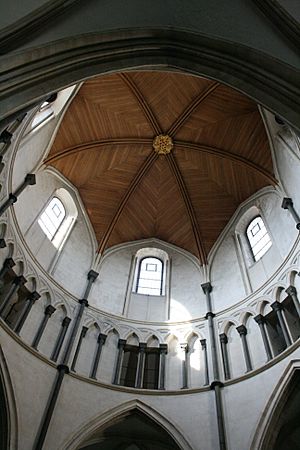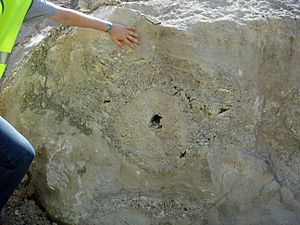Purbeck marble facts for kids

Purbeck marble is a special type of limestone. It is full of fossils, especially tiny shells. You can find it in the Isle of Purbeck. This is a peninsula in south-east Dorset, England. People have dug it up since Roman times. They used it as a beautiful stone for buildings. Today, no one digs for Purbeck marble anymore.
Contents
How Purbeck Marble Formed
This unique stone formed a very long time ago. It was created during the Lower Cretaceous period. This was about 145 to 100 million years ago. Purbeck marble is not a true metamorphic rock. Real marble changes due to heat and pressure. However, Purbeck marble can be polished to a shiny finish. This is why it is called "marble."
Its special look comes from many snail shells. These are from a freshwater snail called Viviparus. The shells are packed tightly together. They are held in a fine-grained limestone mud. Another similar stone is called Sussex Marble.
Colors of Purbeck Marble
The layers of Purbeck marble are found between softer clays. These clays were laid down when the sea moved in and out. Some layers of the marble have iron oxide minerals. These minerals can make the stone red or brown. Other layers contain a mineral called glauconite. This gives the marble a green or sometimes blue color.
Where Purbeck Marble is Found
You can find Purbeck marble across the whole Isle of Purbeck. It is found on the surface or under shallow soil. The marble layers are usually thin. They are never more than 1.2 meters (about 4 feet) thick. Often, they are much thinner. These layers are part of a geological fold. This means they tilt steeply towards the north.
Images for kids
See also
 In Spanish: Mármol Purbeck para niños
In Spanish: Mármol Purbeck para niños



